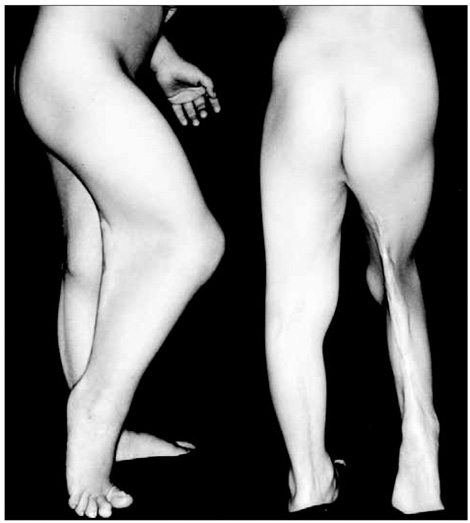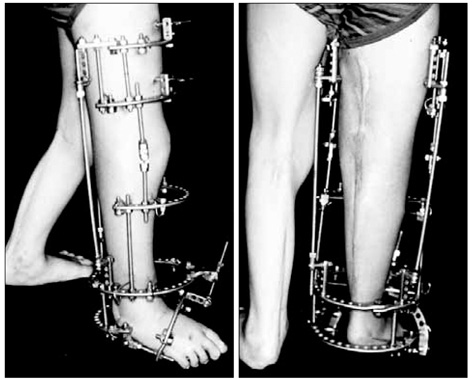Clin Orthop Surg.
2009 Dec;1(4):236-239. 10.4055/cios.2009.1.4.236.
Treatment of Popliteal Pterygium Using an Ilizarov External Fixator
- Affiliations
-
- 1Department of Orthopedic Surgery, The Catholic University of Korea, Bucheon St. Mary's Hospital, Bucheon, Korea. changhoonj@yahoo.com
- KMID: 999407
- DOI: http://doi.org/10.4055/cios.2009.1.4.236
Abstract
- Popliteal pterygium syndrome is a rare congenital disorder that consists of popliteal webs and craniofacial, genitourinary and extremity anomalies. Only moderate successful surgical excision of the fibrotic band within the popliteal web has been reported because the nerves and vessels in the affected site are short and displaced into the web and they are attached to adjacent tissues. We performed hamstring tenotomy on the ischial tuberosity, tenotomy of the flexor hallucis longus and Z-lengthening of the Achilles tendon on the ankle in our patient, and this was followed by gradual correction using an Ilizarov external fixator. Full extension of the knee joint was achieved at the ninth postoperative week. However, some recurrence of flexion contracture was noted at two years follow-up. Gradual soft tissue lengthening with an Ilizarov external fixator can be one of the optimal procedures when excision of a fibrous band and Z-plasty are not possible due to severe adhesion of the nerves and vessels into a fibrotic band. However, a cautious approach is recommended when considering the high risk of recurrence.
MeSH Terms
Figure
Reference
-
1. Herold HZ, Shmueli G, Baruchin AM. Popliteal pterygium syndrome. Clin Orthop Relat Res. 1986. (209):194–197.
Article2. McCall RE, Budden J. Treatment of multiple pterygium syndrome. Orthopedics. 1992. 15(12):1417–1422.
Article3. Herzenberg JE, Davis JR, Paley D, Bhave A. Mechanical distraction for treatment of severe knee flexion contractures. Clin Orthop Relat Res. 1994. (301):80–88.
Article4. Oppenheim WL, Larson KR, McNabb MB, Smith CF, Setoguchi Y. Popliteal pterygium syndrome: an orthopaedic perspective. J Pediatr Orthop. 1990. 10(1):58–64.5. Saleh M, Gibson MF, Sharrard WJ. Femoral shortening in correction of congenital knee flexion deformity with popliteal webbing. J Pediatr Orthop. 1989. 9(5):609–611.
Article6. Kondo S, Schutte BC, Richardson RJ, et al. Mutations in IRF6 cause Van der Woude and popliteal pterygium syndromes. Nat Genet. 2002. 32(2):285–289.
Article7. Bartsocas CS, Papas CV. Popliteal pterygium syndrome: evidence for a severe autosomal recessive form. J Med Genet. 1972. 9(2):222–226.
Article8. Giannotti A, Digilio MC, Standoli L, Zama M, Dallapiccola B. New case of Bartsocas-Papas syndrome surviving at 20 months. Am J Med Genet. 1992. 42(5):733–735.
Article9. Gillen JA 2nd, Walker JL, Burgess RC, Stevens DB. Use of Ilizarov external fixator to treat joint pterygia. J Pediatr Orthop. 1996. 16(4):430–437.10. Parikh SN, Crawford AH, Do TT, Roy DR. Popliteal pterygium syndrome: implications for orthopaedic management. J Pediatr Orthop B. 2004. 13(3):197–201.
Article
- Full Text Links
- Actions
-
Cited
- CITED
-
- Close
- Share
- Similar articles
-
- Treatment of Tibial Condylar Fractures Using the Ilizarov External Fixator
- Treatment of Tibial Fractures using the Ilizarov External Fixator
- Treatment of the Difficult Fractures of the Femur using the Ilizarov External Fixator
- Ilizarov External Fixation for the Complications of Supracondylar Fracture of Femur: Report of two cases
- The Limited Experiences in the Management of the Difficult Fractures of Tibia Using the Ilizarov External Fixator




